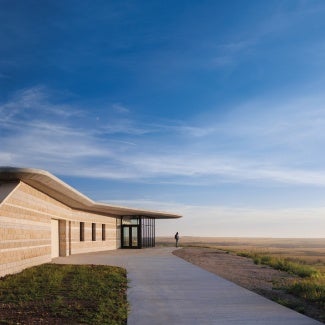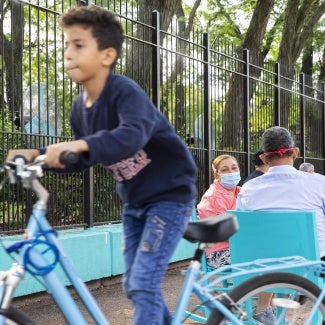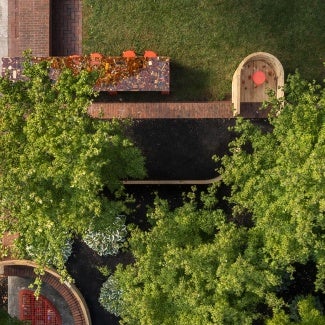Mini Mart City Park
The award-winning small project design of Mini Mart City Park in Seattle transforms a derelict gas station into a vibrant hub for creativity and the arts.

Project highlights: Mini Mart City Park
- Architecture firm: GO'C
- Owner: Mini Mart City Park
- Location: Seattle
- Category: Two
- Project site: Brownfield
- Building program type(s): Public assembly - entertainment/culture
Mini Mart City Park, a community-focused cultural center and park in Seattle’s Georgetown neighborhood, has radically transformed a derelict gas station into a vibrant hub for creativity and the arts. The project is a collaboration between the design team and artist group SuttonBeresCuller, which purchased the brownfield site, that explores the potential of architecture and art to mend an urban concern. With more than 700 similar gas stations in the region and more than 200,000 across the country, Mini Mart City Park is a model for remediation that results in compelling and much-needed community spaces.
The project is situated near the Duwamish River, a critical industrial port for Puget Sound. Because of its legacy of industrial use, the waterway and surrounding land are heavily polluted, so much so that the Environmental Protection Agency designated the five-mile portion that flows through Georgetown a superfund site. Such heavy pollution required careful consideration of how any development could work to improve the site’s soil.
The design for the project, which sits adjacent to Boeing Field, one of the country’s busiest non-hub airports, is focused on creating flexible spaces indoors and out that support art, learning, and community engagement. A significant portion of the site has been returned to the native landscape and public space at ground level. Below it all, a hidden air sparging and soil vapor extraction system advance the team’s concept of “cleaning the earth with art” as it addresses residual petroleum contaminants in the site’s soil and groundwater.
An overarching goal for the project was to create a place to learn about art, architecture, and healthy urban environments, bolstering Mini Mart City Park’s slate of exhibitions and workshops. The community is welcomed into two structures that are linked by a central courtyard, merging built space with the landscaped areas between. The courtyard also hosts large-scale art installations and movie nights for the community and provides loading access for the main gallery. Above, a 1,000-square-foot rooftop serves as an elevated gathering space, surrounded by green roof sections and solar panels.
Construction was supported by a core group of volunteers from Dirt Corps and Duwamish Youth, who spent many hours planting the project’s green roof and surrounding landscape. Local artists designed a series of green wall panels that were installed by members of the Mini Mart City Park’s board and Dirt Corps volunteers. The panels reference the site’s history of contamination while further supporting the growth of native plants.
Framework for Design Excellence measures
Was there a design charrette? Yes
Level of community engagement: Not applicable
Site area that supported vegetation (landscape or green roof) pre-development: 70%
Site area that supports vegetation post-development: 80%
Site area covered by native plants supporting native or migratory species and pollinators: 60 %
Strategies used to promote Design for Ecosystems: Biodiversity, Dark skies, Soil conservation
Is potable water used for irrigation? No
Is potable water used for cooling? No
Is grey/blackwater reused on-site? No
Is rainwater collected on-site? Yes
Stormwater managed on-site: Unknown
2030 Commitment baseline EUI: 51 kBtu/sf/yr
Predicted net EUI including on-site renewables: 16 kBtu/sf/yr
Reduction from the benchmark: Unknown
Is the project all-electric? Yes
Level of air filters installed: Unknown
Was a “chemicals of concern” list used to inform material selection? No
Do greater than 90% of occupied spaces have a direct view to the outdoors? Yes
Were embodied carbon emissions estimated for this project? No
Estimated service life: 100 years
Floor area, if any, representing adapting existing buildings: Not applicable
Ability to survive without utility power: Passive survivability
Risk assessment and resilience services provided: Hazard identification, Hazard mitigation strategies above code
Has a post-occupancy evaluation been conducted? No, and a POE will not be conducted
Building performance transparency steps taken:
Present the design, outcomes, and/or lessons learned to the office
Project team & jury
Year of substantial project completion: 2022
Gross conditioned floor area: 1100 sq. ft.
Architect: GO'C
Artists: SuttonBeresCuller
Structural Engineer: J Welch Engineering
Civil Engineer: J Welch Engineering
Kinetic Window: Chris McMullen Productions
Lighting Design: Fixture Studio
Landscape Consultant: Wittman Estes
Envelope Consultant: RDH Building Science
General Contractor: Métis Construction
Chandra Robinson, AIA, (Chair), LEVER Architecture, Portland, Ore.
Katherine Hogan, AIA, Katherine Hogan Architects, Raleigh, N.C.
Chris Baribeau, AIA, Modus Studio, Fayetteville, Ark.
David Corban, AIA, David Corban Architects, Naples, Fla.
Madhubala Ayyamperumal, Assoc. AIA, Gensler, San Francisco
AIA and its Small Project Design (SPD) Knowledge Community present the annual Small Project Award Program to raise public awareness of the value and design excellence that architects provide regardless of the limits of size and budget.
Nine projects showcase the best small project design and the big impact small projects can have on people and communities.













